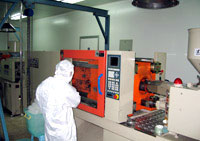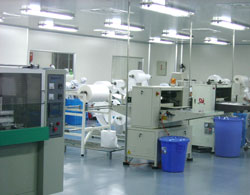Specifications of PES and PP cartridge filters

Clean room for manufacturing PES and PP cartridge filters.
Absolute vs High Efficiency vs Nominal
In practical terms, Absolute means all particulates below a specified size
are removed.
In quantitative terms, most mfgs employ the standard of >99.98%
efficiency.
PES cartridges exceed this 99.98% standard.
High Efficiency is typically reserved for filters of >90% efficiency. Our PP filters exceed this 90% standard.
Nominal filters are typically
60-70% efficient.
Filter sheets and lenticular filters are nominal filters. Also, spun polypropylene as you see at hardware stores are nominal filters.
We do not sell nominal filters except our ACF carbon filter is also a nominal 5 micron filter.
What is BETA? Beta is simply another means of expressing efficiency. A filter of 99% efficiency allows 1 particulate out of 100 to pass. The Beta = 100. A filter of 99.98% efficiency lets 2 in 10,000 pass ( or 1 in 5000). Beta = 5000. So Absolute filters have Beta > 5000.
["Absolute" PP filters?? Some manufacturers refer to high-efficiency PP cartridges as "absolute" or perhaps "semi-absolute". This is misleading because they are not "absolute" at the labeled porosity. For example, our 0.22 micron PP cartridge is 95% efficient (not absolute) for 0.22 micron particles, but 99.98% efficient (which is absolute) for 2.5 micron particles. We reserve the term "absolute" to PES cartridges to avoid confusion, and also to accurately reflect the intended use of the filter--as a final microbial filter.]
